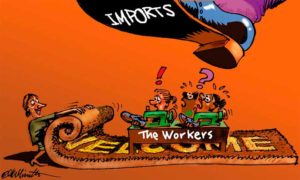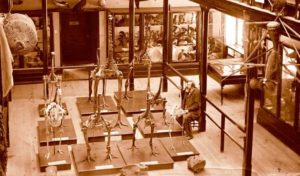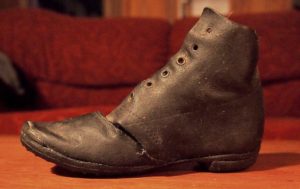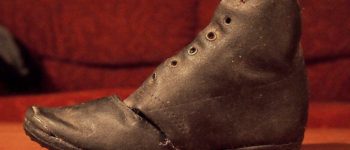1992: The New Zealand Shoe
November 12, 2020
By AHNZ
Once was a time that New Zealand had a prominent domestic shoe industry. Kiwis valued durable shoes and if they did wear out or break they would be repaired with new sole or by re-stitching. For about two generations now we’ve had a disposable society: If your shoes wear out you throw them out and buy some more from China or India or Vietnam. That change was delivered by National 4.0 as they lowered the drawbridge of Fortress New Zealand, allowing imported shoes to flood in to the ruination of the domestic industry.
Pedestrian Nation
 Our standard of living is so high now that homeless people live in their motor cars! When citizens feared being infected with COVID-19 it led to traffic jams as the ‘walking wounded’ rolled out in their cars to testing stations leading to blocked up roads. Poverty has had to be re-defined, inflated, to indicate ‘deprivations’ that earlier New Zealanders took for granted.
Our standard of living is so high now that homeless people live in their motor cars! When citizens feared being infected with COVID-19 it led to traffic jams as the ‘walking wounded’ rolled out in their cars to testing stations leading to blocked up roads. Poverty has had to be re-defined, inflated, to indicate ‘deprivations’ that earlier New Zealanders took for granted.
We fly and catch trains and taxies and the bus on a daily basis. Or, we drive our own car or ride our own bike or rental scooter. Our ancestors walked, by necessity, so valued excellent and hard-wearing shoes. Sometimes the horses were shod better than the person driving them and ploughing the fields. For example, young Keith Holyoake did this work with no shoes on at all…
“The absorption of life’s lessons is permanent when carried out barefoot behind a horse-drawn plough. Just as the stone bruises from the fields penetrated deep, so too did the correspondence lessons.” – biography of Keith Holyoake¹
“Good hard-wearing footwear was vital in those days because most people walked everywhere. In Reefton in the 1880s there were no fewer than 8 boot and shoe makers. Only wealthy people owned horses.”- John Rosanowski²
“The line of cars outside the Ōtara pop-up testing centre in south Auckland snaked back as far as the eye could see on Wednesday morning.”- Coronavirus: Long queues at Covid-19 testing stations as NZ moves alert levels; Stuff
“I live out in Karaka…the nearest public transport service near me is a 1.5km walk away for a bus to catch a train station. So all of the people who live around in my community are car dependent.” – Former Chief Executive of Infrastructure New Zealand, now independent consultant, Stephen Selwood³
According to transport expert Stephen Selwood the trek of 1.5km to public transport that can take you anywhere is such a trial, such a distance, that it renders an entire community “car dependent.” I wonder what generations prior to GenX, Millennials, and Zoomers would think of that? For most of our history a 1.5km walk was how you got to school or milked the cows or visited the start of your driveway. For the people planning our infrastructure now, 1.5km is an isolating disability requiring of a prosthetic device, a car, to depend upon!
Maybe New Zealanders would value good and durable shoes now the way we once did if Governments were not assuming the posture that we are invalids who have lost the use of our feet? But I guess you don’t get to tax people and blow their money on lots of transport infrastructure to ‘save them’ from ‘transport poverty’ unless you objectify the traveller as Selwood has, do you?
Government vs New Zealand Shoes
The New Zealand domestic shoe industry has been like some endangered parrot. If it had been left alone to face the global market it would have done OK. Instead, The State has inflicted a long history of distortions and subsidisations that are supposed to ‘help’ the shoemakers. Then, after about 130 years of this native parrot being fed government bread crumbs and kept on a predator-free island, the bird was docile and flightless and fat and vulnerable when the doors of global competition swung open!
“The government put a duty of one shilling a pair on imported boots from the 1860s, making them more expensive and therefore helping to encourage the local industry.”
“By 1895 New Zealand had 65 boot and shoe factories, producing more than a million pairs annually.”
“The government restricted footwear imports from 1938, and increased tariffs on imports to protect the local footwear industry.”- Te Ara
“When cuts on tariffs began in 1991, the import tax on footwear was gradually reduced from 55 percent..It walloped the local shoe industry.”
” In the 1930s, the government introduced tariffs on imported footwear in order to protect the burgeoning Kiwi shoe industry and until the late 1980s, about 95 percent of the footwear sold in New Zealand was made on our shores”- Ref. Good Magazine
 National 4.0, in stages, phased out the protections that had been the norm for the fat parrot that was our domestic footwear industry. Fortress New Zealand opened up the cage to competition and, predictably, the vulnerable local shoemaker and repairer was unable to evolve 130 years worth within less than a decade and was gobbled up like a takahe in a piranha tank. Ruth Richardson’s Mother of all Budgets saw to the lifting of the protectionism from 1992 and even the change in government to Labour 5.0 didn’t undo the strife to this endangered species.
National 4.0, in stages, phased out the protections that had been the norm for the fat parrot that was our domestic footwear industry. Fortress New Zealand opened up the cage to competition and, predictably, the vulnerable local shoemaker and repairer was unable to evolve 130 years worth within less than a decade and was gobbled up like a takahe in a piranha tank. Ruth Richardson’s Mother of all Budgets saw to the lifting of the protectionism from 1992 and even the change in government to Labour 5.0 didn’t undo the strife to this endangered species.
“National had more than met its side of the bargain with the New Zealand’s protected manufacturers. The government was fast bringing about price stability, lowering the tax burden, reducing interest rates, and had passed into law the Employment Contracts Act…The over-all economic liberalisation programme was seven years old- more than fair warning for protected manufacturers. The quid pro quo for all of these considerations was continued significant reductions in tariffs.”- Richardson (1995)
 Like bones of a largely extinct species, old shoes frequently show up in our archaeology because they were so prevalent and so durable. It’s hard to know what New Zealand shoes might have been if the evolutionary path had not been disrupted by The State since the 1860s or sooner. Or, what if Ruth Richardson had not ended the corporate welfare plan for shoes at all but it had kept up? Today we might have some evolutionary dead-end when it came to shoes, only able to buy local ones at the prices and designs chosen by politically protected local manufacturers. We might have to be stopped at the airport and have to turn over our shoes or at least declare them if they were made outside Fortress New Zealand.
Like bones of a largely extinct species, old shoes frequently show up in our archaeology because they were so prevalent and so durable. It’s hard to know what New Zealand shoes might have been if the evolutionary path had not been disrupted by The State since the 1860s or sooner. Or, what if Ruth Richardson had not ended the corporate welfare plan for shoes at all but it had kept up? Today we might have some evolutionary dead-end when it came to shoes, only able to buy local ones at the prices and designs chosen by politically protected local manufacturers. We might have to be stopped at the airport and have to turn over our shoes or at least declare them if they were made outside Fortress New Zealand.
“And they turned Formosa into a shoe factory called Taiwan..”- Roger Waters
It’s very hard to take a domesticated animal/industry and re-introduce it into the wilds of free market competition. If The State had just left shoes alone from the start there wouldn’t be this big mess. Without the tampering, who knows? New Zealanders might have been world-leaders at making shoes or may yet turn out to be.
We can’t just blame the government for doing this. It probably all started and continued when shoe-makers made a devil’s deal by asking for government protection in the first place. In the moment, they captured market share and made lots of money for their firms and their families. The New Zealand consumer had to pay extra for the limited choices of his locally made shoes and was forced, by successive governments (who got their cut, don’t worry) to prop up the protected industries. Anyone could have foreseen that this was a hidden tax, unfair to the consumer and leading to a endangered or extinct industry but nobody wanted to recognise it. Statism is a group delusion where we don’t think about long term costs. We don’t think about killing off an entire industry or generations of cheated shoe consumers later if it means we can keep a clinically dead parrot on life support for 5 more minutes.
—
1 Ref. p24, The Holyoake Years; Ross Doughty (1977)
2 Ref. West Coast History; Facebook
3 Huge rise in Aucklanders driving to work vs bus or cycle; RNZ (Nov 2020)
Ref. p121, Making a Difference; Ruth Richardson (1995)
Image ref. Child’s boot found near Barrytown; Sophie Allan, West Coast New Zealand History
Image ref. Prime Minister Jim Bolger and Finance Minister Ruth Richardson, 1991 budget; NZ Herald; Te Ara
Image ref. Clark keeps the footwear tariffs going in 2003; Ashley W. Smith; Alexander Turnbull Library; Te Ara
One thought on "1992: The New Zealand Shoe"
Leave a Reply
 Like Comment Share
Like Comment Share








test